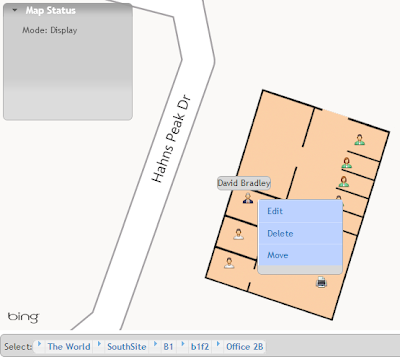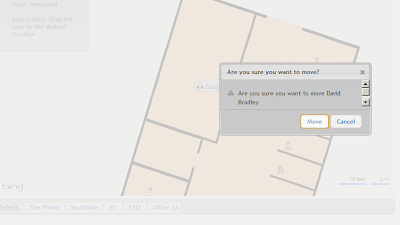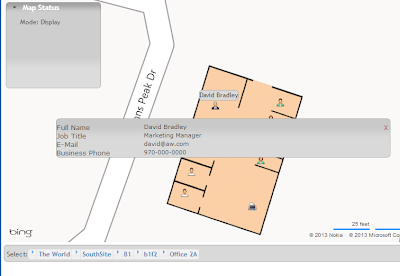Building Information Management vs. Building Information Modeling?
 |
Personnel location information on the
SharePoint Bing Mapper Directory System.
|
Recently I’ve embarked on creating this blog largely to discuss my latest project, the SharePoint Bing Mapper Directory System (“The Mapper” as I will refer to it in this post). I want to be able to share my ideas on the concept of placing organizational information on a Bing Map. Exploring the ideas behind The Mapper has led to some interesting quandaries.
My big question is how to classify this application. I have done a lot of research lately at looking in to the field of managing information around campuses, buildings, locations in general. I keep finding myself looking the concept of building information modeling. Building information modeling is an all-encompassing science that models in an architectural context of a building or buildings. Different versions of BIM(odeling) include everything from the beginning of a project to cost and time information to full lifecycle and demolition planning.
That’s great, but how is that going to help the person sitting in the lobby of an office building filled with 1,000 workers?
How will it help the I.T. personnel charged with tracking equipment throughout the organization?
How will it help a HR person in locating a person in a building they’ve never seen before or to assign and track who sits at what desk, cubicle or office?
What about flexible spacing such as at trade shows? Is BIM(odeling) the answer to RAD style applications for managing those types of spaces?
This brings us to The Mapper and the concept of Building Information Management. Might I be splitting hairs with the naming? Sure. The concept I have worked through and created The Mapper to address is the stuff where we get down to usability type information. This type of information is what an end user would consume. This type of information relies on BIM(odeling) for accurate physical details (floor plans, site layouts, etc.) but is intended to convey business centric information coupled with building detail visualized on a web enabled map (in this case Bing Maps).
 |
| Floor plan of the CSU Administration building on the SharePoint Bing Mapper Directory System. |
BIM(anagement) is intended to be more service oriented, to provide answers to general users and to allow easy management of information related to people and items in relation to location. The platform is designed to be extensible, making RAD development possible for information to be visualized on a map.
Envision this scenario: An operator of a complex that hosts multiple conventions each year would like to automate the registration process for each convention. By combining BIM(odeling) with a layout of the convention and making it available through a web browser the process can be streamlined. The host can place booth availability, size, location and cost information on the map. A registration form can be provided directly over the space on map, once the space is reserved it can be instantly marked as taken and provide the name of the occupant. Using this same information, the show layout can be displayed on a public site as a directory for those attending the show. The same information can also be used by maintenance crews for setup and teardown. This is Building Information Management, the combining of the model with business scenarios.
And since this is The SharePoint Mapper, a more SharePoint centric example: SharePoint, for those who have not been initiated, by default contains people information and a search based profile tool. When combined with The Mapper, you can retrieve a list of people with a link that can display where the persons assigned office/desk is located. Okay, that is not a big deal if everyone in the company is sitting in the same building, however in a large organization with many campuses and many buildings it is a nice tool to have. In this way The Mapper goes beyond BIM(odeling), combining multiple campuses to provide a map based contextual setting easily shared across an organization.
Geez, there you have it, my concept of Building Information Management…Perhaps it should be Organization Location Management…








